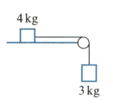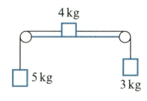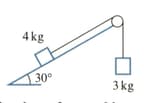A train consists of an engine and five carriages. The engine has mass and each carriage has mass The engine produces a driving force of The resistance force on the engine is and the resistance on each carriage is The train moves in a straight line on a horizontal track. Find the tension in the coupling between the third carriage and the fourth carriage. Take .
Important Questions on Connected Particles
In each of the following diagrams, the blocks are at rest and are connected by light strings passing over smooth pulleys. Any hanging portion of a string is vertical and any other portion is parallel to the surface. Unless marked otherwise, the surfaces are rough and horizontal. In each case, find the magnitude of the tension in each string and the magnitude of any frictional force.

In each of the following diagrams, the blocks are at rest and are connected by light strings passing over smooth pulleys. Any hanging portion of a string is vertical and any other portion is parallel to the surface. Unless marked otherwise, the surfaces are rough and horizontal. In each case, find the magnitude of the tension in each string and the magnitude of any frictional force.

In each of the following diagrams, the blocks are at rest and are connected by light strings passing over smooth pulleys. Any hanging portion of a string is vertical and any other portion is parallel to the surface. Unless marked otherwise, the surfaces are rough and horizontal. In each case, find the magnitude of the tension in each string and the magnitude of any frictional force.

In each of the following diagrams, the blocks are at rest and are connected by light strings passing over smooth pulleys. Any hanging portion of a string is vertical and any other portion is parallel to the surface. Unless marked otherwise, the surfaces are rough and horizontal. In each case, find the magnitude of the tension in each string and the magnitude of any frictional force.

A bucket of mass rests on scaffolding at the top of a building. The scaffolding is above the ground. The bucket is attached to a rope that passes over a smooth pulley. At the other end of the rope there is another bucket of mass which initially rests on the ground. The bucket at the top of the building is filled with of bricks and is gently released. As this bucket descends, the other bucket rises.
Find how long it will take the descending bucket to reach the ground.
